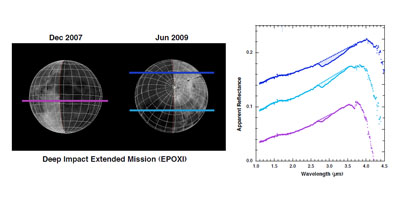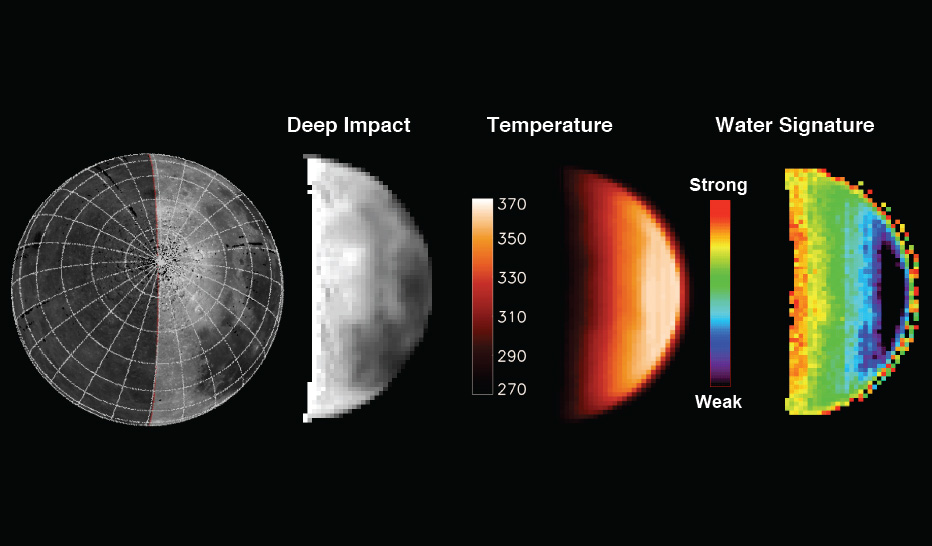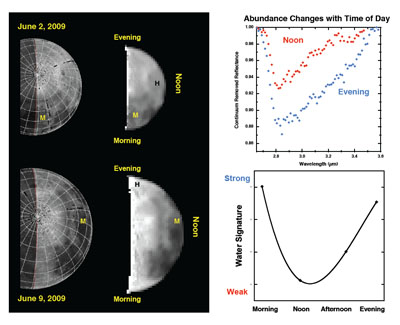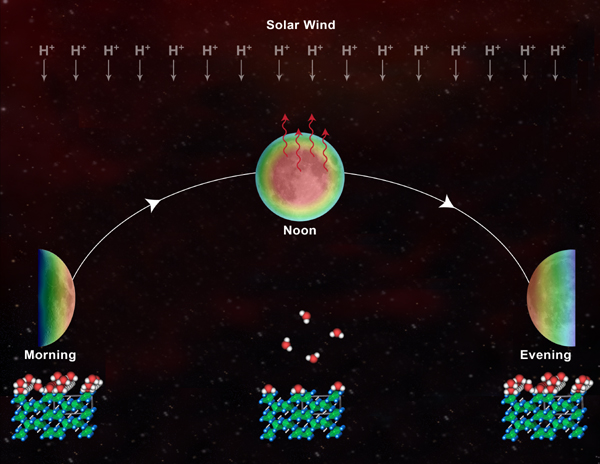EPOXI
Two intriguing investigations -- One flight-proven spacecraft
News: Deep Impact and Other Spacecraft Find Clear Evidence of Water on Moon, 2009.09.24
Press Release
Deep Impact and Other Spacecraft Find Clear Evidence of Water on Moon2009.09.24
Thin layer of surface 'dew' appears to form, then dissipate each day
Deep Impact Identifies Water on the Lunar Surface
Since successfully carrying out its spectacular impact experiment at comet Tempel 1 on July 4th, 2005 the Deep Impact spacecraft has been on an extended mission (EPOXI), which culminates in a flyby of comet Hartley 2 on November 4th, 2010. En route to the comet, the Deep Impact spacecraft observed the moon for calibration purposes on several occasions. In June 2009, the northern polar regions were observed and average spectra were collected (blue and cyan). These data unambiguously include the entire OH/H2O absorption feature (hashed regions; 2.7 to 3.6 µm). This water signature varies in strength. In particular, data acquired over the warm equator (purple; Dec 2007) have a distinct but weaker water signature.
Credit: NASA/University of Maryland
Water Abundance is Dependent on Temperature in Deep Impact Maps
Deep Impact observations of the northern polar regions (~60 km/pixel; June 9, 2009). Left to right: Clementine basemap (with 15° grid) of observed area; Brightness image generated from Deep Impact (at 1.2 µm); Temperature map (in K) derived from >4 µm spectra; Map of the strength of the water signature (continuum-removed 2.8 µm band depth). There are significant variations in the water signature across the lunar surface. While the strength of the water signatures is not correlated with terrain type (bright highland vs. dark maria), but is dependent on temperature.
Credit: NASA/University of Maryland
Water Abundances Change with Time-of-Day
Deep Impact observations of the north pole (June 2 and 9, 2009) separated by one week, or 1/4 of a lunar day reveal variations in the strength of the OH/H2O absorptions with time-of-day. For example, a mare unit (‘M’) is observed in the morning on June 2, but by June 9 is at local noon. Similarly, a highland unit (‘H’) begins at noon and rotates to evening on June 9. A significant change in the strength of the OH/H2O absorptions is observed, for example, for the highland unit, which has weaker/narrow absorptions near noon (red) and stronger/broader absorptions by evening (blue). Taken together these Deep Impact data show a systematic change with water loss from morning to noon, recovery through the afternoon, and a return to steady state by evening. This cycle requires a daytime source for rehydration and is therefore consistent with solar wind.
Credit: NASA/University of Maryland
Daytime Water Cycle on the Moon
This schematic shows the daytime cycle of hydration, loss, and rehydration on the lunar surface. In the morning, when the moon is cold, it contains water and hydroxyl (OH). One theory holds that the water and hydroxyl are, in part, formed from hydrogen ions in the solar wind. By local noon, when the moon is at its warmest, some water and hydroxyl are lost. By evening, when it is colder, the surface returns to a state equal to that seen in the morning. Thus, regardless of location or terrain type, the entire surface of the moon is hydrated during some part of the lunar day.
Credit: University of Maryland/O. Groussin/McREL
Return to the press release.
[See the original mission result writeup and graphics.]
Lee Tune
University of Maryland, College Park
301-405-4679
ltune [at] umd [dot] edu
RELEASE: 09157, Source




